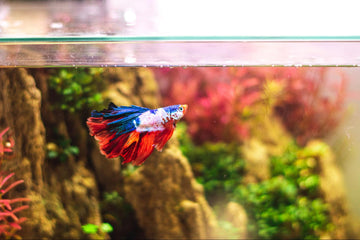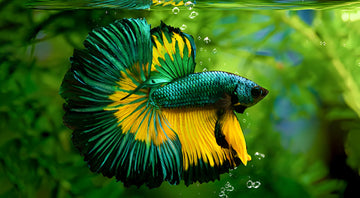How To Tell If A Betta Fish Is Male Or Female

Contents
The Betta fish, also known as the Siamese fighting fish, is like a vibrant and captivating work of art swimming in the tranquil freshwater ponds and streams of Southeast Asia. With their striking colors and elaborate fin displays, Betta splendens have become a beloved addition to aquariums worldwide.
But here's the thing: if you want to give your Betta the best care possible, you need to know their gender. Males and females have unique physical and behavioral traits you can't afford to ignore. This knowledge is especially crucial if you're planning to keep your Betta in a community tank, where the aggressive nature of males can lead to severe territorial disputes.
So, how do you tell them apart? Well, learning to recognize the differences between male and female Bettas not only expands your fishy knowledge but also ensures a peaceful and harmonious aquatic habitat for your scaly friend. So dive in and discover the secrets of your Betta's gender!
Exploring the Vibrant Life of Betta Fish
Betta fish (Betta splendens), originating from Southeast Asia's warm, shallow waters, have adapted to thrive in various environments, ranging from rice paddies to slow-moving streams.
They are renowned for their stunning physical characteristics, including vibrant colors, intricate patterns, and elaborate fins. However, these attributes go beyond mere aesthetics and play a vital role in Betta fish's social and reproductive behaviors.
Among Betta fish, males are particularly known for their striking appearance and aggressive tendencies. They often engage in displays of dominance to protect their territory or attract a mate, so they earned the nickname "Siamese fighting fish."

This territorial nature and desire to attract mates emphasize the importance of distinguishing between genders in the Betta world. This is a significant consideration for both enthusiasts and breeders, as it helps understand and cater to the unique needs and behaviors of male and female Bettas.
How many types of betta fish are out there? Check out our article.
Understanding the nuances between males and females is also essential for a multitude of other reasons:
- It enables us to provide customized care, nutrition, and tank setups that meet their needs.
- It helps prevent aggressive behavior that often arises when male fish share the same space, considering their territorial instincts.
- By understanding these nuances, Betta fish owners can enhance their joy of ownership by meeting their fish's unique requirements and maintaining a peaceful aquarium setting.
- It streamlines the breeding process by enabling effective pairing of fish.
With this knowledge, you can provide customized care that fosters a peaceful environment in your tank. Now, let’s explore the specific physical and behavioral characteristics that set male and female Bettas apart.
Physical Differences Between Male and Female Betta Fish
Betta fish have distinct physical differences between males and females, each carrying unique traits that distinguish one from the other.
Size and Shape
Betta fish exhibit notable differences in size and shape between males and females, key indicators of their gender.
|
Gender |
Body Shape |
Average Size |
Fin Length |
Appearance |
|
Male |
Elongated and flat |
2.5 to 3 inches |
Long and elaborate |
Streamlined and flamboyant |
|
Female |
Shorter and rounder |
Up to 2 inches |
Shorter |
Subdued and less extravagant |
These physical distinctions are part of the betta fish’s sexual dimorphism, where the two sexes exhibit different characteristics beyond just their reproductive organs. In the case of betta fish, these differences are particularly pronounced, making it relatively straightforward to distinguish males from females based on size and shape alone.
Fin Length and Shape
Betta fish are renowned for their spectacular fins, varying in length and shape across different breeds. These fins contribute to their aesthetic appeal and serve important functions in swimming and display.
|
Gender |
Caudal Fin |
Dorsal Fin |
Pelvic Fins |
Anal Fin |
Ventral Fins |
|
Male |
Long and elaborate |
Pointed |
Thicker and longer |
Extended |
Longer and thicker |
|
Female |
Shorter |
Rounded |
Thin and short |
Fan-shaped and shorter |
Short and rounded |
These differences are not just aesthetic but also serve practical purposes. The males’ longer fins are used in mating displays to attract females and to deter rivals, while the females’ shorter fins allow for better mobility and less energy expenditure during egg-laying activities.
Color Patterns
The vibrant coloration of Betta fish is one of their most striking features, and it varies significantly between males and females.
|
Gender |
Vibrancy |
Patterns |
Purpose |
Variability |
Intensity |
|
Male |
Often very vibrant, with a wide range of colors |
Display a kaleidoscope of patterns, often with metallic sheens |
Use bright colors to attract females and intimidate rivals |
Exhibits significant color changes when stressed or during courtship |
Coloration can be an indicator of health and vitality |
|
Female |
Generally less vibrant, with more subdued hues |
Can possess patterns, though typically less complex and more uniform |
Subtler colors may aid in evading predators, especially when caring for young |
Color changes are less pronounced and usually relate to health or stress levels |
While less flashy, some females display rich colors, challenging perceptions of dullness |
The difference in coloration between the sexes is not just for aesthetic appeal but also plays a role in Betta’s reproductive strategy. Males use their bright colors to signal their fitness to potential mates, while females, with their less conspicuous appearance, may better avoid predators, especially when caring for their young.
Gill Cover Size
The gill covers, also known as the operculum, play a crucial role in the respiratory system of Betta fish, allowing them to breathe by covering and protecting the delicate gills. There are noticeable differences in the gill cover size between male and female Betta fish.

Males are equipped with larger gill covers that they can flare impressively to signal dominance or attract mates. This flaring can make the gill covers appear even more prominent, and it’s often referred to as the “beard” due to its resemblance to facial hair when extended. The ability to flare these gill covers widely is a distinctive characteristic of male Betta fish, often used in confrontations with other males or as part of their mating display.
Females, on the other hand, have smaller gill covers. While they can flare them, it is a less frequent behavior and not as visually striking as in males. The smaller size of the female’s gill covers is less conspicuous, which may be advantageous in avoiding unnecessary attention from predators or aggressive males.
Behavioral Differences
Territorial Behavior
Betta fish also exhibit distinct territorial behaviors that vary between males and females. Understanding these differences is crucial for betta fish care and tank management.
|
Gender |
Aggression |
Social Structure |
Territorial Displays |
Interaction with Same Species |
|
Male |
Highly aggressive, prone to combat with other males. |
Solitary, cannot coexist with other males without risk of severe aggression. |
Create bubble nests, and flare fins, and exhibit bright colors and elaborate finnage. |
Cannot be housed with other males due to aggressive territorial behavior. |
|
Female |
Less aggressive, can establish territories but less likely to fight. |
Can live in groups (sororities) with a social hierarchy, though careful monitoring is needed. |
Subdued appearance with shorter fins and less vibrant colors to avoid attention from males. |
Can coexist with other females if a pecking order is established and maintained. |
While both male and female bettas are territorial, the intensity and nature of their behavior differ significantly. These behavioral traits should be considered when setting up a betta fish tank to ensure a harmonious environment.
Nesting Habits
One of the most distinctive behaviors of male Bettas is their skillful construction of bubble nests. Using bubbles produced by their labyrinth organ, males create floating structures at the water's surface to house eggs during breeding. The quality and size of these nests indicate the male's reproductive fitness and readiness to spawn.

While males build and maintain bubble nests, females play a crucial role in the reproductive process. Once a suitable nest is constructed, the female inspects it before depositing her eggs, often signaling her readiness through courtship behaviors.
After spawning, females may actively care for the eggs, guarding them against predators, and ensuring their survival.
Interaction with Other Fish
Male bettas are known for their territorial nature. They often exhibit aggressive behaviors such as flaring their gills and chasing to assert dominance, especially when they encounter other males or fish that resemble them in appearance. This aggression is a natural instinct, as male bettas are solitary creatures in the wild and compete for territory and mating opportunities. This behavior can be problematic in an aquarium setting, leading to stress and injury if multiple males are kept together or if tank mates are too similar in appearance.

Female bettas have a better temperament
On the other hand, female bettas can exhibit aggression but are generally more sociable than their male counterparts. They can be housed together in groups known as sororities, where they establish social hierarchies. Maintaining a sorority in a spacious tank with ample hiding spots is crucial to reduce stress and prevent aggressive encounters.
When considering a community tank with bettas, choosing tank mates is essential. Peaceful and non-competitive fish that do not resemble bettas are usually suitable companions. Fish that are calm and occupy different tank areas, such as bottom dwellers, can coexist with bettas without triggering their territorial instincts.
Challenges in Identifying Young Bettas
Identifying young Bettas can be challenging due to their underdeveloped physical characteristics. Juvenile Bettas often lack the distinctive features that differentiate males from females, such as fin length and body shape. Additionally, their color patterns, which are a key indicator of maturity and gender, may not be fully developed.
Age-related Appearance Changes
As Bettas age, their appearance evolves dramatically. In their first six months, they can grow up to one inch per month, transforming in size and fin intricacy. Older Bettas typically boast longer, more intricate fins than their younger counterparts.
Similarly, the vibrancy of their scales shifts over time, while young Bettas often dazzle with their bright colors, older individuals may adopt a subtler palette, with their once-vivid hues fading to more understated tones.
This progression in physical appearance with age adds to their mystique and introduces challenges in gender identification, particularly in the early stages of a Betta's life.
Tips for Gender Identification in Juveniles
Gender identification in juvenile Bettas can be aided by observing several factors:
- Fins: Male Bettas typically have longer, flowing fins than females, with shorter, more rounded fins.
- Egg Spot: Female Bettas have a small white spot on their underbelly, the ovipositor, used to lay eggs.
- Behavior: Male Bettas are generally more aggressive and territorial, while females are more passive.
- Body Shape: Females usually have a rounder body shape, whereas males are longer and slimmer.
Remember, these indicators might not always be definitive in juveniles since their features are still maturing. A dash of patience and continuous observation will become your best tools in confidently determining the gender of young Bettas.
Conclusion
From the vibrant and elongated fins of the males to the more subdued hues and rounded bodies of the females, each gender of Betta fish exhibits unique traits that are truly awe-inspiring. As we have explored, recognizing these differences, especially in juvenile fish, requires patience, keen observation, and a solid understanding of Betta biology.

Whether setting up a new tank, considering breeding, or simply aiming to provide the best care for your Betta, appreciating these nuances is crucial. If you are looking to deepen your understanding or enhance your Betta's environment, TrophicFlow offers a wide range of resources and products designed to support the health, longevity, and happiness of your aquatic companions.
Take a dive into TrophicFlow's offerings to discover how to create the ideal habitat for your Betta fish, ensuring they thrive and display the full spectrum of their natural beauty.
No comments











0 comments